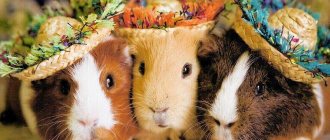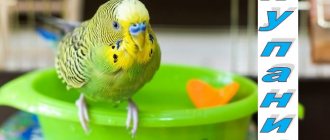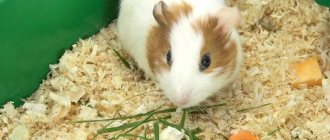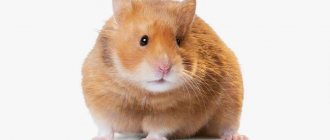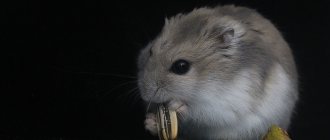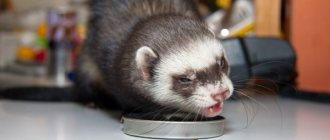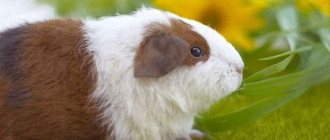When keeping any pets in a house or apartment, the issue of hygiene arises. Nature provides opportunities for self-cleansing of animals. This process is not always associated with water procedures.
Guinea pigs are very clean. But, despite the intriguing name, they do not like to swim. It is possible that a specific smell will be heard from the animal. And then you can’t do without water and shampoo. It is important to know how to bathe your guinea pig correctly so as not to harm it.
When should you bathe your guinea pig?
It is better not to carry out bathing procedures for pigs without compelling reasons. This is extra stress for her. Washing your guinea pig just for fun is not worth it.
Arguments that speak in favor of swimming:
- The rodent's fur is overgrown with clumps, dirty areas are clearly visible;
- the animal’s fur coat has become dull; despite all his efforts, he is unable to put it in order on his own;
- before the “introduction”, in preparation for the upcoming exhibition, bathing guinea pigs is a common procedure;
- sticky growths have formed in the tail area;
- a bad smell began to emanate from the animal.
Most often, pigs are bathed if they spend most of their time in enclosures built in the yard.
Pros and cons"
The rodent is considered a clean animal. Normally, he cleans himself up, and the guinea pig does not need to be washed additionally. In the natural environment, of course, no one gives water treatments to animals.
The rodent takes care of the fur on its own: licks it with its tongue as needed, and then smoothes it with its paws.
If the animal is healthy, if the conditions that you have organized for it are favorable, you should not bathe it. For a rodent, water procedures will be stressful: and children, who most often insist on a piggy bath, should explain this immediately after purchase.
But there are arguments that suggest that sometimes a guinea pig still needs to be washed.
Let's consider in what situations the animal should be washed.
- If tangles, lumps, or impurities formed due to various reasons are visible on its fur with the naked eye. This can happen to a pig if it “runs off for a walk” or walks in an outdoor enclosure during the warm season.
- If you see that your pet’s fur has become dull, if you can’t call it shiny and lively, perhaps the pig is unable to wash itself. This also happens. In this situation, she needs help.
- If the next day is an important exhibition where you are going to show your pet in all its glory, the pig needs a bath as a spa. In order for the fur to shine, the animal will have to endure water treatments.
- If the pig begins to smell unpleasant, you should definitely wash it as carefully as possible.
- Pay attention to the condition of the pig's sebaceous gland. Where the animal has a tail, there is an organ responsible for the production of sebum. To be more precise, a special secretion is produced from the gland, which, like pheromones, acts on representatives of the opposite sex. The sebaceous gland is a fatty, oily area that looks like a small bald spot. And if you find crusts in this place, the guinea pig definitely needs to be bathed.
As you can see, the reasons for swimming do not include “curiosity,” “idle interest,” or reasons like “I think she wants to swim.” Therefore, do not expose the animal to stress again: water is a frightening situation for him.
When should you not bathe your guinea pig?
It is not always possible to wash your guinea pig. Factors that do not allow this to be done at this point in time:
- The pet is still very small, its delicate coat is not yet dirty;
- when a rodent has just changed its place of residence, you need to wait until it gets used to it and stops worrying about its housewarming;
- This cannot be done in the cold season, there is a very high probability of hypothermia from a draft;
- Swimming is strictly contraindicated for a pregnant female;
- a sick animal may not tolerate bathing, you need to wait until it recovers;
- If, when immersed in water, the pet desperately escapes from your hands and squeaks loudly, bathing should be postponed and limited to wiping the fur with a damp cloth.
Before you decide to bathe a capricious pet, you need to think carefully about whether this can be done? If there is at least one of the contraindications, the water activity should be abandoned until better times.
At what age can you bathe?
Small guinea pigs should not be bathed. Their immunity has not yet been formed, and their exposure to stress is extremely high. Young animals have a hard time withstanding temperature changes; a draft after a bath in almost 100% of cases leads to a cold and further health complications.
It is recommended to bathe pigs at home no earlier than they are 5–6 months old.
How to prepare an animal for a bath
There are very rare exceptions to the rules when a pig willingly dives into water and also swims with pleasure. This means that the genes of distant ancestors who lived near water made themselves felt.
Most often, if an animal unexpectedly finds itself in the water, it will be perceived with aggression and fear. To avoid such a negative reaction, the pig should be prepared in advance for the fact that it will have to take a bath.
At least 5 days before the planned bathing, they begin to accustom the animal to going to the bathroom. He needs to get comfortable in a new place and perceive this place without fear or suspicion. If the animal gets scared, you can calm it down with gentle intonations of your voice, give it your favorite treat, or pet it.
You can train your rodent to brush its hair in the bathroom. When he gets used to the environment, the next stage begins: carefully place him in a cup without water. The bath procedure will be carried out in this container in the future. The next day, turn on warm water. The animal's paws will get wet, it will explore a new sensation in a familiar environment, without fear listening to the sound of falling water.
Washing guinea pigs will not be difficult if all these preparatory steps have been completed.
Training
Exposing your pig to unusual conditions can cause stress to a greater or lesser extent. To avoid an unpleasant moment, the rodent is gradually accustomed to water procedures.
- About a week before day X, especially if washing is happening for the first time, the animal is brought into the bathroom for a few minutes every day. Here you talk to your pet, gently stroke it, brush it, or just play.
- The second step is getting used to a basin or sink. The pig is placed in a container and allowed to get comfortable there.
- Turn on the shower or faucet, but do not direct the stream at the animal. This will allow your pet to get used to the sound of water and not be afraid of it in the future.
After all these activities, you can proceed directly to washing.
How to bathe a guinea pig correctly
If you place an animal in a bathtub or in a cup with high sides, it will have the desire to jump out of there. You need to be prepared for the fact that the soaped body is very slippery, and it will be difficult to hold the pig with your hands. It must be remembered that falling from any height means inevitable injury, sometimes incompatible with life.
If you carefully think through the place for swimming, the procedure will be easier. It is possible that your pet will even enjoy bathing and will ask you to do it from time to time.
The water in the basin, which will serve as a bath, should be filled no more than to the level of the pet’s abdomen.
The pig will be more comfortable if a small woven cotton napkin is placed at the bottom of the bathing container. By grabbing it with her paws, she will stand more confidently.
Even if the animal normally tolerates the sound of a running stream from a tap, turn on the water if absolutely necessary. It is convenient to water the animal from a scoop without lifting it high.
When the entire coat is wet, apply shampoo. When a guinea pig bathes, it is advisable to calm it down with a calm monologue and gentle stroking.
You need to foam the shampoo carefully, without making sudden movements. When massaging your back, you should not press hard on it. Particularly dirty areas, especially in the tail area, are cleaned with soapy cotton wool.
While your pet is in the basin, you need to make sure that water and detergent do not get into his eyes or ears. This may cause conjunctivitis and otitis media.
The detergent is washed off as thoroughly as possible to prevent further entry into the rodent’s food tract.
Long-haired animals could use a little balm, after which the hair will be combable better and will become smooth and shiny.
Immediately after finishing the bathing procedures, the animal is wrapped in a soft, slightly warm towel to absorb water. He is released into the cage after he has dried thoroughly.
We make the drinker ourselves
If you don’t have extra funds or want to avoid low-quality hazardous materials, you can try making a drinking bowl yourself. To make a ball sippy cup, you will need:
- pen;
- plastic bottle;
- bearing (bicycle);
- sandpaper;
- silicone based sealant;
- stationery knife.
Step-by-step making of a ball drinker with your own hands:
1. It is necessary to disassemble the handle into its components - you will need its body. 2. Remove the ball from the bearing. 3. Next, you should place the ball in the body from the handle; it usually locks. Make a notch at this point; the unnecessary part needs to be cut off (you can use a hacksaw). 4. Blow into the handle, if there is an air passage, you need to remove excess parts, fixing the ball tightly. 5. Make a hole at the bottom of the plastic container to insert the pen body. 6. To avoid water leakage, apply sealant at the joint. 7. It is necessary to fix the former handle at an angle of 45 °, so the water will flow freely when acting on the ball.
The advantages of a home drinking bowl are that it is made with love for your pet and has a long service life. Disadvantages - not everyone can do this on their own; children will have to resort to the help of adults.
How to properly dry guinea pigs after bathing
Dry the animal using a soft towel. Gently massage the back, changing the wet towel to a dry one if necessary. When the fur coat becomes almost dry, it needs to be combed. If this is not done immediately, the wool may become matted.
Blow drying your pet is not a good idea. Most animals are terrified of this device. You can scare a pig so much that bathing it next time will be a big problem. Pet owners justify blow-drying by the coolness of the room and the fear of catching a cold in their pet. However, bathing an animal in the cold is generally contraindicated.
A hot air stream from a hairdryer can easily dry out the animal's skin or even burn it. If you choose a low temperature, your pig will catch a cold. Therefore, there are more dangers from a hairdryer than benefits.
What should shampoo be like?
Detergents intended for humans are not suitable for pigs. When the question arises of how to wash your pet, you don’t need to listen to your friends who claim that they get by just fine with soap or regular shampoo. Veterinarians warn: small animals have very sensitive skin; it is easily irritated by improperly selected detergents.
If you choose between soap and shampoo, the second remedy is preferable. Soap is more difficult to rinse off and also makes the coat hard.
Special shampoos for rodents are sold in every pet store or veterinary pharmacy. Their price is not so high that you save on your pet’s health. Products intended for bathing dogs are not suitable. You can buy hygiene products for cats and rabbits.
A brief overview of detergents for rodents:
- “Piggy” - this pet shampoo contains hypoallergenic plant components and glycerin in its base. This product will give the animal silky and shiny fur.
- “Shustrik” is a specially developed detergent composition without dyes for animals that are sensitive to chemicals. The value of this shampoo is that it moisturizes the skin and has an anti-inflammatory effect. The fur will comb well, without tangling.
- Api-San Royal Groom is a fortified cleaning product that, thanks to selected herbal ingredients, moisturizes the skin well, acts as an effective bactericidal and healing agent, and treats dandruff.
- Beaphar is a pet shampoo that has no side effects, does not irritate sensitive skin, gently cleanses, foams well, and is environmentally friendly.
If it is not possible to purchase pet shampoo, and the contamination is severe, it is permissible to bathe the guinea pig at home with shampoo or soap intended for babies. But it is not recommended to constantly get out of the situation in this way.
Zoo shampoo is purchased in advance, in parallel with the equipment for the cage, so that if necessary it is always at hand.
Necessary accessories
To wash a rodent, you need to prepare in advance:
- basin;
- shampoo for rodents, in exceptional cases you can use regular baby shampoo;
- plastic watering can or mug;
- flannel diaper;
- towel,
- hair dryer,
- cotton buds,
- baby cream or oil (vaseline, any vegetable).
Some owners use dog washing products to bathe pigs at home, but this is not recommended, since the concentration of surfactants in them is too high for small animals. Also, do not wash with soap - it dries the skin too much, which will lead to flaking and dandruff.
Experienced pig breeders also note that it is most convenient to wash the pig in a sink or bathtub, with a diaper placed on the bottom so that the pet’s paws do not slip.
For your own safety, it is better to bathe your animal with gloves, which will protect your hands from possible scratches and bites. Indeed, in stressful situations, even the cutest animal turns into an inadequate and aggressive predator.
Final procedures
It will not be possible to completely dry the animal right away; this process will be completed naturally within a few hours. Therefore, after a bath, you should not take the animal outside for about a day. Drafts and cold rooms are strictly contraindicated.
After finishing bathing, experts recommend wiping the animal’s sebaceous gland in the tail area with a cotton pad and treating this area with an antiseptic, for example, chlorhexidine.
There should be no sawdust in the cage. They may stick to the fur. During this period, you can lay paper or waffle towels on the bottom of the cage.
Before putting a washed and dried animal into the cage, you can offer it “snacks”. He will receive such encouragement for long-term patience with gratitude and remember this pleasant moment. It will be much easier to wash your guinea pig next time.

